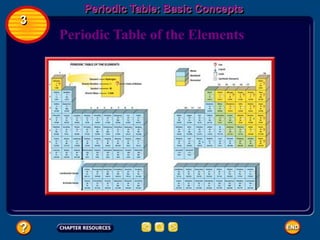
Mod3
- 1. Periodic Table: Basic Concepts 3 Periodic Table of the Elements
- 2. 3 Periodic Table • Atomic number = the number of protons • Each element has a specific number of protons which makes it that element • Electrons: each element initially has the same number as protons. • Electrons: are found in energy levels around the nucleus
- 3. 3 Periodic Table • Electrons: 1st energy level holds 2 electrons (e-). The rest of the energy levels want 8 e-. • Electrons: the last energy level is the important one. Will give up or take e- to obtain the magic number 8. • The periodic table columns (1-18) tell you how many e- are in the last energy level.
- 4. 3 Periodic Table • Elements will either give up or take e- to obtain stability (8) • Elements on the left side of the table tend to give up e-’s and elements on the right side of the table tend to take e-’s. • Column 18 elements have 8 in their last energy level.
- 5. Periodic Table: Basic Concepts 3 Relationship of the Periodic Table to Atomic Structure
- 6. Periodic Table: Basic Concepts 3 Electrons in Energy Levels—Group 16
- 7. Periodic Table: Basic Concepts 3 Electrons in Energy Level The electrons in the outermost energy level are called valence electrons. You can also use the periodic table as a tool to predict the number of valence electrons in any atom in Groups 1, 2, 13, 14, 15, 16, 17, and 18. All atoms in Group 1, like hydrogen, have one valence electron. Likewise, atoms in Group 2 have two valence electrons.
- 8. Atomic Structure: Basic Concepts 3 Electrons in Energy Level An oxygen atom has eight electrons. Two of these fill the first energy level, and the remaining six are in the second energy level.
- 9. 3 Formation of compounds • Na (Sodium) is in column 1 and has 1 valence e-. It will give up this e- because the energy level below it has 8. • Cl (Chlorine) is in column 17 and has 7 valence e-’s. It will gain 1 e- to have 8.
- 10. Formation of Compounds: Basic Concepts 3 Electrons Can Be Transferred • Because the chlorine atom now has an extra electron, it has a negative charge. • Also, because sodium lost an electron, it now has an unbalanced proton in the nucleus and therefore has a positive charge.
- 11. Formation of Compounds: Basic Concepts 3 Formation of Water by Electron Sharing • The oxygen, by sharing two electrons with two hydrogens, claims a stable octet in its outer level. • By this method, each atom achieves a stable noble gas configuration.
- 12. Bonding and Polarity 3 • Ionic bonding: oppositely charged • Covalent bonding: share e-
- 13. Chemistry 3 • Requirement: • For each element, hydrogen, carbon, potassium, oxyge n, and sodium, determine the following: • a. Does it bond ionically or covalently? • b. How many energy levels does it have? • c. How many valence electrons does it have?
- 14. Chemistry and Matter: Additional Concepts 4 Scientific Methods • Often, a scientist will begin with qualitative data—information that describes color, odor, shape, or some other physical characteristic that relates to the five senses. • Chemists also use numerical quantitative data. • A hypothesis is a possible explanation for what has been observed. • An experiment is a set of controlled observations that test a hypothesis.
- 15. Chemistry and Matter: Additional Concepts 4 Scientific Methods • The variable that is changed in an experiment is called the independent variable. • The variable that you watch to see how it changes as a result of your changes to the independent variable is called the dependent variable.
- 16. Chemistry and Matter: Additional Concepts 4 Scientific Methods • Many experiments also include a control, which is a standard for comparison. • A conclusion is a judgment based on the data obtained in the experiment. • If data support a hypothesis, the hypothesis is tentatively affirmed. Hypotheses are never proven; they are always subject to additional research.
- 17. Chemistry and Matter: Additional Concepts 4 Scientific Methods • Over time, data from many experiments can be used to form a visual, verbal, and/or mathematical explanation—called a model—of the phenomenon being studied. • A theory is an explanation that has been supported by many experiments. • Theories are always subject to new experimental data and are modified to include new data.
- 18. Chemistry and Matter: Additional Concepts 4 Scientific Methods • A scientific law describes a relationship in nature that is supported by many experiments and for which no exception has been found.
- 19. Chemistry and Matter: Additional Concepts 4 Scientific Research • Pure research is done to gain knowledge for the sake of knowledge itself. • Applied research is undertaken to solve a specific problem.
- 20. Additional Assessment Questions 4 Question 1 Identify the dependent variable and the independent variable in the following experiments.
- 21. Additional Assessment Questions 4 Question 1a A student tests the ability of a given chemical to dissolve in water at three different temperatures. Answer 1a independent variable: dependent variable:
- 22. Additional Assessment Questions 4 Question 1b A farmer compares how his crops grow with and without phosphorous fertilizers. Answer 1b independent variable: dependent variable:
- 23. Additional Assessment Questions 4 Question 2 Classify each kind of research as either pure or applied.
- 24. Additional Assessment Questions 4 Question 2a A scientist studies plants in a rain forest in search of chemicals that might be used to treat AIDS. Answer 2a
- 25. Additional Assessment Questions 4 Question 2b A researcher studies the effects of hormones on the brain of a worm. Answer 2b
- 26. Additional Assessment Questions 4 Question 2c A researcher tries to develop cleaner burning fuels to help reduce air pollution. Answer 2c